Difference between revisions of "Modding"
| Line 13: | Line 13: | ||
<H2>Hookup</H2> | <H2>Hookup</H2> | ||
<H3>Fairchild Video Entertainment System / Channel F</H3> | <H3>Fairchild Video Entertainment System / Channel F</H3> | ||
| − | [[File:Channel F composite hookup point.jpg|300px]] | + | [[File:Channel F composite hookup point.jpg|300px]] [[File:Channel F composite video mod improve signal.jpg|400px]] |
| + | <br><br> | ||
| + | Connect composite signal to the resistor by the RF box where the black clamp is placed. <br> | ||
| + | Audio can be picked directly from speaker output using about 150kOhm in series.<br> | ||
| + | To improve image quality you can desolder RF shield and remove (or just lift one leg) L2 coil and resistors R28, R25<br> | ||
| + | This will disconnect 5V from RF circuit and also disconnect it from the composite signal<br> | ||
| + | Use GND and +5V connecting from the electrolytic cap on the 5V regulator output <br> | ||
| + | <br> | ||
<br> | <br> | ||
| − | |||
| − | |||
<H3>Channel F II</H3> | <H3>Channel F II</H3> | ||
| − | [[File:Channel F II composite video modification overview.jpg|439px]] [[File:Channel F II composite mod detail.jpg|300px]] <br> | + | [[File:Channel F II composite video modification overview.jpg|439px]] [[File:Channel F II composite mod detail.jpg|300px]] <br><br> |
| − | |||
| − | <br> | ||
5V can be picked directly from the capacitor, here connected with red and blue wires in top right position of the circuitboard. <br> | 5V can be picked directly from the capacitor, here connected with red and blue wires in top right position of the circuitboard. <br> | ||
| − | One of the locations for composite signal source has been hooked up with a red clamp on a resistor by the LED. <br> | + | One of the locations for composite signal source has been hooked up with a red clamp on a resistor by the LED. <br><br> |
| − | + | [[File:Channel F II composite video modification jumper.jpg|434px]] [[File:Channel F II mod Composite points.jpg|420px]] | |
| − | |||
| − | |||
| − | |||
| − | |||
<br> | <br> | ||
| + | <br> You can lift the jumper in the green circle to improve video quality. <br> | ||
| + | Optional composite video hookup points are located there, marked with green dots.<br><br> | ||
| + | [[File:Channel F II composite mod audio.jpg|320px]] [[File:Channel F II mod voltage divider.jpg|460px]] <br> | ||
| + | Audio hookup is found right of the channel switch. Connect a 22kOhm and 100kOhm as a voltage divider from GND ro red dot.<br> | ||
| + | This will give an audio volume close to the one via the RF-signal. <br> | ||
| + | Green dots have a low level audio signal, if used instead you may get interference if skipping an inline resistor (R8 in schematic). | ||
| + | <br><br><br> | ||
<H3>SABA Videoplay 2</H3> | <H3>SABA Videoplay 2</H3> | ||
[[File:SABA Videoplay 2 composite video mod hookup.jpg|402px]] | [[File:SABA Videoplay 2 composite video mod hookup.jpg|402px]] | ||
[[File:SABA Videoplay 2 composite mod second image.jpg|365px]] | [[File:SABA Videoplay 2 composite mod second image.jpg|365px]] | ||
<br> | <br> | ||
| − | In this example 5V and ground is hooked up directly to the 5V regulator, | + | In this example 5V and ground is hooked up directly to the 5V regulator, composite signal is taken from capacitor pin (yellow wire).<br> |
The white wire from the speaker is originally connected to the little RF board, connect it to the PCB instead.<br> | The white wire from the speaker is originally connected to the little RF board, connect it to the PCB instead.<br> | ||
In the image you see audio hooked up with a loose resistor and capacitor instead of using the PCB. | In the image you see audio hooked up with a loose resistor and capacitor instead of using the PCB. | ||
Revision as of 15:56, 14 March 2023
Contents
System Fairchild composite video modification
Working mod schematic
Construction can be used for many other machines as well.
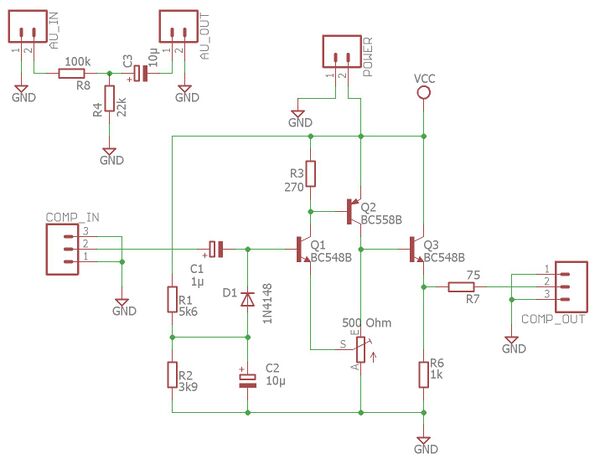
Example PCB
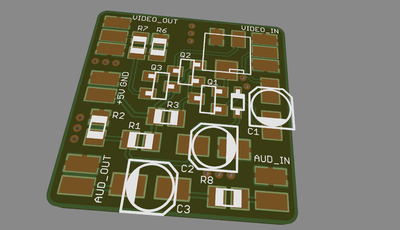
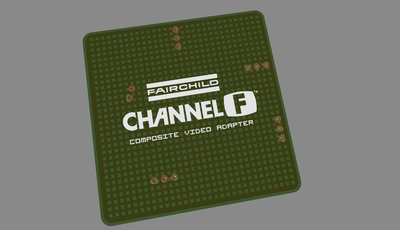
Example of PCB using SMD components.
Hookup
Fairchild Video Entertainment System / Channel F
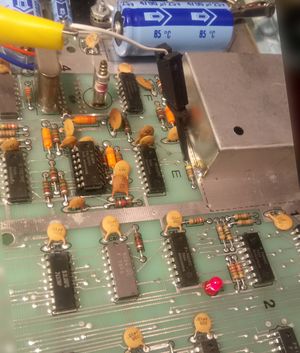
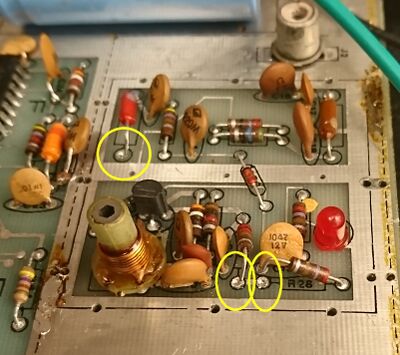
Connect composite signal to the resistor by the RF box where the black clamp is placed.
Audio can be picked directly from speaker output using about 150kOhm in series.
To improve image quality you can desolder RF shield and remove (or just lift one leg) L2 coil and resistors R28, R25
This will disconnect 5V from RF circuit and also disconnect it from the composite signal
Use GND and +5V connecting from the electrolytic cap on the 5V regulator output
Channel F II
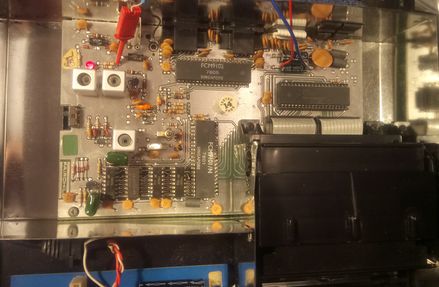
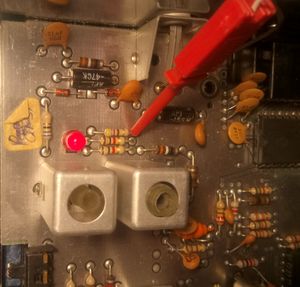
5V can be picked directly from the capacitor, here connected with red and blue wires in top right position of the circuitboard.
One of the locations for composite signal source has been hooked up with a red clamp on a resistor by the LED.
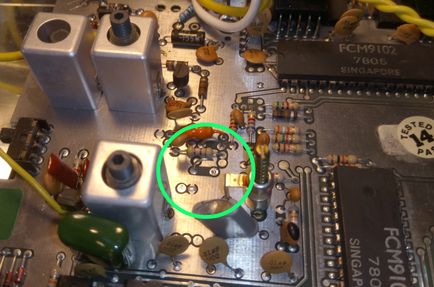
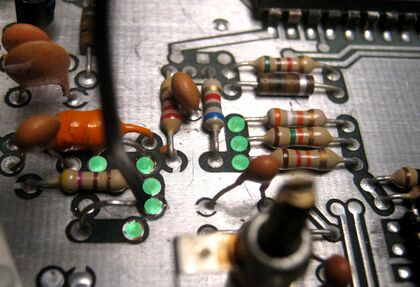
You can lift the jumper in the green circle to improve video quality.
Optional composite video hookup points are located there, marked with green dots.
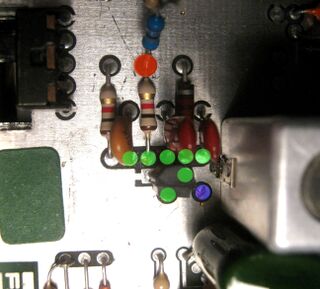
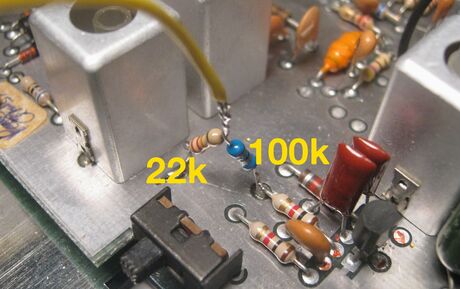
Audio hookup is found right of the channel switch. Connect a 22kOhm and 100kOhm as a voltage divider from GND ro red dot.
This will give an audio volume close to the one via the RF-signal.
Green dots have a low level audio signal, if used instead you may get interference if skipping an inline resistor (R8 in schematic).
SABA Videoplay 2
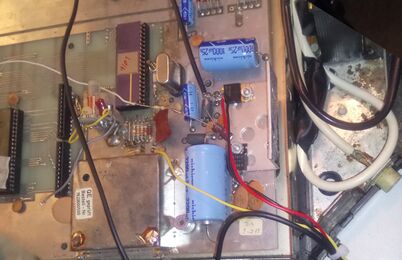
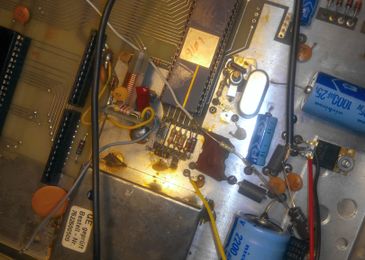
In this example 5V and ground is hooked up directly to the 5V regulator, composite signal is taken from capacitor pin (yellow wire).
The white wire from the speaker is originally connected to the little RF board, connect it to the PCB instead.
In the image you see audio hooked up with a loose resistor and capacitor instead of using the PCB.